Oi Brazil! eu te amo!
Niru Kumar, MBA ’13 experiences Brazil for the first time in a Johnson study trip.

A Johnson Study Trip to the southern hemisphere – a journey of wonder, discovery and pure joy!
Spending the turn of the new year at the ‘still being built’ terminal 4 of JFK, all I could think of was – this better be worth it. Not knowing how exactly to plan my trip from Ithaca to NYC, I had been very conservative about New Year’s Eve estimates in NYC and ended up in JFK 14 hours before my flight time. The 14 hour stay at JFK also included spending my New Year’s Eve with random students who also decided to be cautious like me. We were all excited, but at the same time bored, as we waited for boarding different flights taking us to different corners of the world.
Finally the early morning counters at TAM, the Brazilian airline, opened. I ran to get checked in and to get my I-94 removed a final official procedure that signals my emigration from the USA. My friends from Johnson joined me on the flight as we started the journey. Special meal requests meant that I was served the best Indian food I had tasted on a Brazilian airline! We reached Sao Paulo airport 10 hours later. Our hotel, the cab, the airport all had been very inviting and we were looking forward to the start of the trip!
Day 1
We started out with a great Brazilian lunch buffet after which we left for a visit to old downtown of Sao Paulo to see some historic buildings. We visited the oldest skyscraper in Brazil and learned its amusing history.
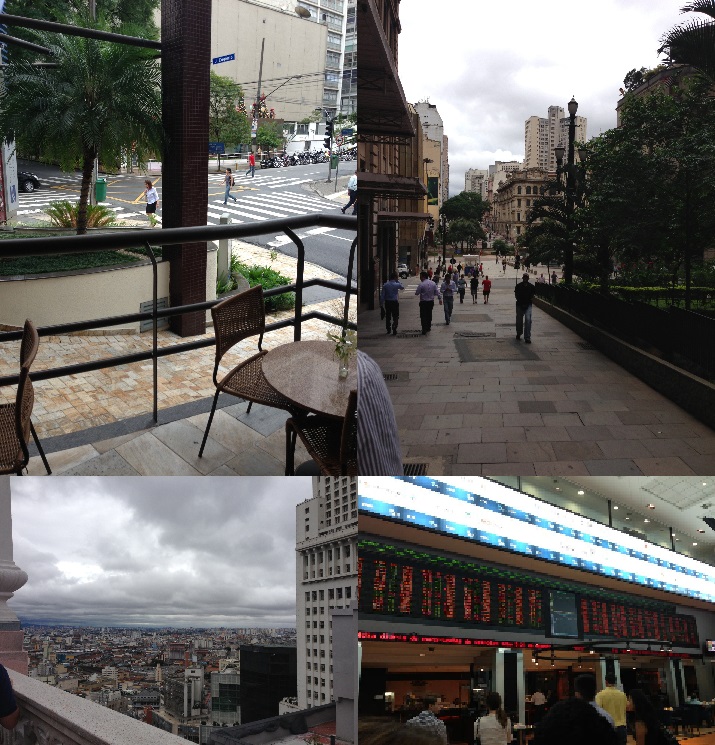
From left clockwise: It was great to see Christmas decorations in the hot summer weather of the southern hemisphere, views of the historic downtown Sao Paulo, view inside the stock exchange in Brazil, view from atop the oldest historic skyscraper in historic downtown Sao Paulo
We then visited the famous Brazilian stock exchange BMS Bovespa. The stock exchange is now fully electronic so I was disappointed not to see people screaming in a pit. I was impressed that the exchange had not one but two sustainability related indices. The exchange has special classes where women are educated about investing. This is because Brazilians still have the culture of the husband giving all his salary earnings to his wife and of the wife making all the decisions about the household spending including investments. Thus BMS Bovespa decided to give investment education to women to help spur the investment culture in Brazil!
We finally ended the day with a visit to a Brazilian steak house. We were also met by a US Consul in Sao Paulo who is in the 2013 CQMBA program at Johnson. Being a Cornellian, he wanted to make sure he met us. At the steakhouse, I was amazed that there were enough salads, vegetables and pastas for a vegetarian like me to eat. Truly a nice experience having a relaxing 4 hour dinner! Brazilian buffet spreads everywhere also seem to include a lot of sweets or dolce made of everything imaginable from Passion Fruit to chocolate to coconut and even pumpkin! Their sweet sense is very close to the Indian sense of sweet, and having a sweet tooth, I was not complaining!
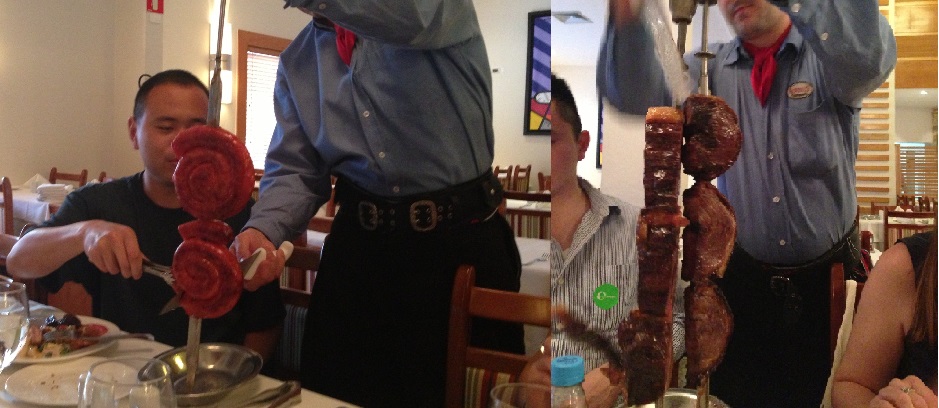
From left to right: Some kind of grilled sausage being served, this is the best cut of beef (or so I have learned :)) being served to our group
Day 2
We started the next morning with a one hour drive to the Natura headquarters in Cajamar. Being an engineer, I never thought I would be so amazed by a cosmetics company. Their use of ingredients and sustainability practices in their processes and employee management can impress anyone. They also pay their employees well above the national minimum wage, one of the many social causes they believe and practice.
Natura is also very famous for having the largest network of independent “consultants,” and they solely sell their products only through such consultants. They have a direct sales model, similar to the business model used by Amway. This model is so popular in Brazil, that many Brazilian women prefer to only consult and by their cosmetics from their “consultant” friends for their beauty and skin care needs. Hence many companies with a store sales based model have found it extremely difficult to break into the Brazilian beauty market. Brazil has one of the largest beauty markets in the world, but a direct sales network is not only difficult but time intesive for any new entrant to set up and hence new market entry would take years.
Natura also has a great line of products, including products based on extracts of plants and fruits from the Amazon. We all were very fortunate to get free samples of these products. Brazil also has the largest range of shampoo products in the world since it is a very diverse and very multi racial country. Natura also has a production line that follows a ‘produce to order’ model. Many companies follow this model, but an important point to note is that the order sizes in the case of Natura are not large million dollar orders. They are small orders placed by each of their million individual ‘consultants’. While this could be a coordination and production line nightmare for other companies, this is daily business for Natura. Natura is also famous for making cosmetics for older women and has a line of cosmetics suited for women’s skins of every decade. For example their 60+ is suited for women over 60 while their 70+ line is suited for women over 70. Natura is also famous for not using any models in its advertisements and using ordinary women for marketing its products. I loved all the advertisements they showed us and I was surprised by how well the advertisements resonated with me even though they were in Portuguese. We also learned about Natura expressions, which is about helping your friends relax through soothing touches. I know many people in that room who had to go above and beyond their comfort zone to give the Natura expressions routine to their classmates! We came back to our hotel and attended excellent presentations about the Brazilian economy from two Brazilian professors – Cristina Helena Pinto de Mello and Hugo Pinto de Souza Junior. Finally we ended the day with a fun trip to the Skye Bar. Located at the roof top of a boat shaped building, this bar is visited by the successful and rich folks of Sao Paulo.
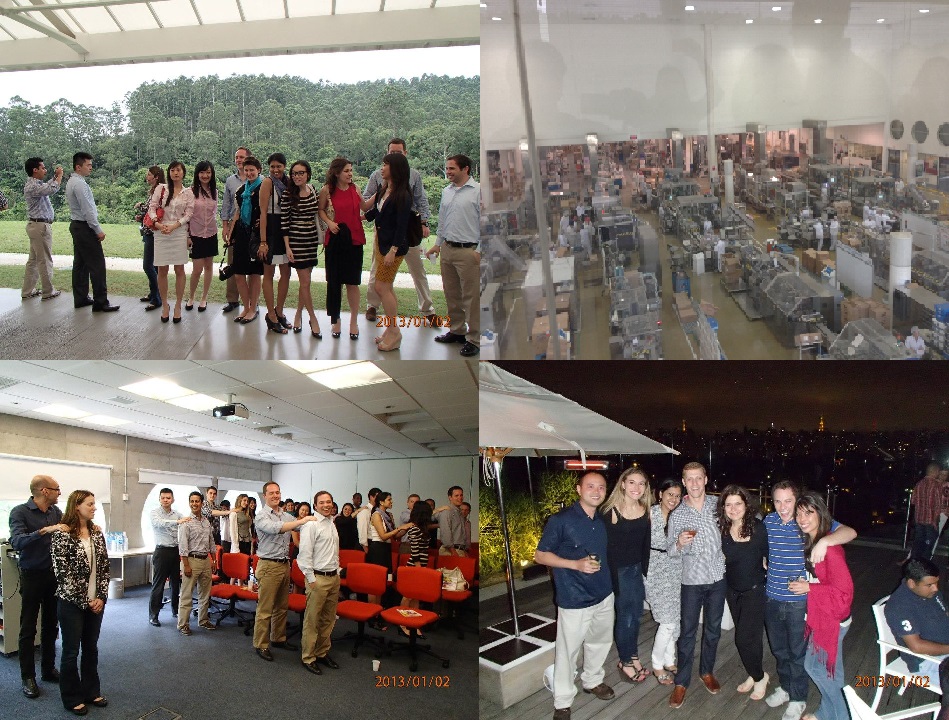
From left clockwise: Natura is trying to conserve the woodlands seen behind us by planting and re-planting local trees, one of its many sustainability related initiatives, the manufacturing floor where individual packages are also made for every ‘consultant’ based on what they ordered for their own clients, view of Sao Paulo in the night from the Skye Bar, giving the Natura expressions routine to our classmates
Day 3
We started Day 3 with an excellent early morning talk by the president of Havaianas, the manufacturer of famous flip flops from Brazil. Havaianas is a classic example of how bad marketing can cause a product to be considered a poor man’s necessity, which is what Havaianas were in Brazil for many years. By listening to their clients, redesigning their products, better product placements, launching smart product lines and finally using great marketing with celebrity endorsements, Havaianas can today boast about being one of the national symbols of pride for Brazil. Now marketed and sold worldwide, Havaianas are very popular in many regions of the world. Havaianas is a classic story of how just following the basic marketing principles can help a company turn around and achieve record sales and growth and also become a formidable worldwide fashion statement. I also found out that they had bought the brand ‘Hawaii Slippers’ in India from Bata shoes, which is an almost identical product very popular in India. I feel that ‘Hawaii slippers’ still suffer from a low brand image in India, but given the image turnaround in Brazil, I am very sure Havaianas will be able to achieve the same success in India. At the end of the talk, our group also got flip flop key chains for free!
We then went on a visit to Itau, the second biggest bank in Brazil in terms of assets and tenth largest bank in the world in terms of market cap. We heard a great talk by their CFO, which later inspired me to do an entire project on Itau for my Sustainable Global Enterprise class. I was impressed by the bank’s initiatives towards social, environmental and financial responsibilities. Itau Unibanco follows the equator principles; it has special programs for helping business reduce their GHG emissions and to also help businesses be environmentally and socially responsible. Itau also has a unique program with specially selected and trained employees for its microcredit program. The bank also helps with the cultural and social development in Latin America, including helping build a positive Latin American identity. During my trip later to Rio, I was also amazed by all the Itau bikes parked in the touristy spots of Rio. This is being done to not only help tourists be mobile, but to also provide a clean and healthy urban mobility alternative for the residents of Rio. The main aspect that I am truly impressed with the bank is the use of a financial, social and environmental screening process even when extending corporate credit. This is very unique for a bank, especially for a bank in an emerging market since one would think such banks would only be interested in bottom line numbers.
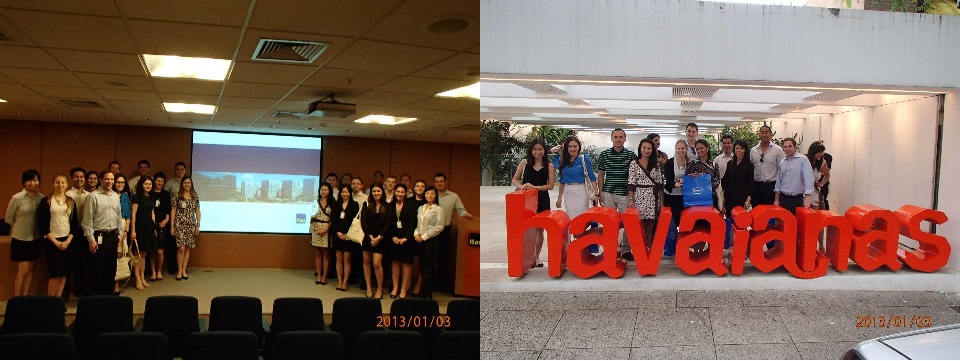
Left to right: The Johnson student trek group with the CFO of Itau Unibanco, all of us posing in front of the Havaians store in Rua Oscar Freire
We then visited the cement giant Votorantim to learn more about its successful cement business. The company does a lot more than cement, but the cement business is what Votorantim is known for. From there we went to the ‘Madison Avenue of Brazil’ – Rua Oscar Freire Street in Sao Paulo. After becoming excited by the morning’s talk on Havaianas, we went shopping for them in the Havaianas Rua Oscar Freire street outlet. This outlet is known for being their model store where you can even get your own custom made Havaianas. In this store you can get flip flops which cost as little as $12 or cost as high as $200! We also went to the only Natura outlet, which is again in Rua Oscar Freire for some cosmetics shopping. After our shopping we spent the night in the Vila Madalena neighborhood for a pub crawl. It turned out to be a rather touristy affair with the organizers taking us to some extremely old and infrastructure-wise questionable bars. I would suggest that if you are in Sao Paulo and want to spend an evening in the Vila Madalena neighborhood, do it on your own.
Day 4
We left for Paraty, an old well preserved colonial town with the most beautiful buildings and beaches. There were no paved roads which connected this town until a few decades ago. As a result, the town has a well-preserved colonial town setting which one should not miss. Being surrounded by beautiful mountains and beaches and being the cachaca capital of the world, only helps the cause of its tourist popularity. We lived in small Brazilian hotels called Pousadas and my hotel amongst other good things also served free dinner. Paraty being a small town is not exactly for vegetarians like me and folks in Paraty including in the Pousadas do not speak English. So while dinner in our hotel was free, it was a complete test of my new found Portuguese skills to enquire and order vegetarian dishes. I also learned Portuguese for how to order hot water for my special tea, towels for pool outings and repellent to fight the insects. By the end of my two day stay in Paraty, I was very impressed with the amount of Portuguese I had learned.
Day 5
The next day we went on a boat tour to visit the famous beaches around Paraty. Our very own private boat was equipped with good food, caipirinhas and snorkeling equipment. Since it was our own private boat, we could park it at any beach or any water spot that looked enticing enough to swim. The night was finally spent in Paraty 33 to celebrate the end of our trip to this beautiful colonial town. The music in the main town square was simply amazing and the night festive. While we enjoyed some good live Brazilian music, I treated myself to some good vegetarian Acarajé (Deep fried black bean balls), the first fried/cooked food item in two days!
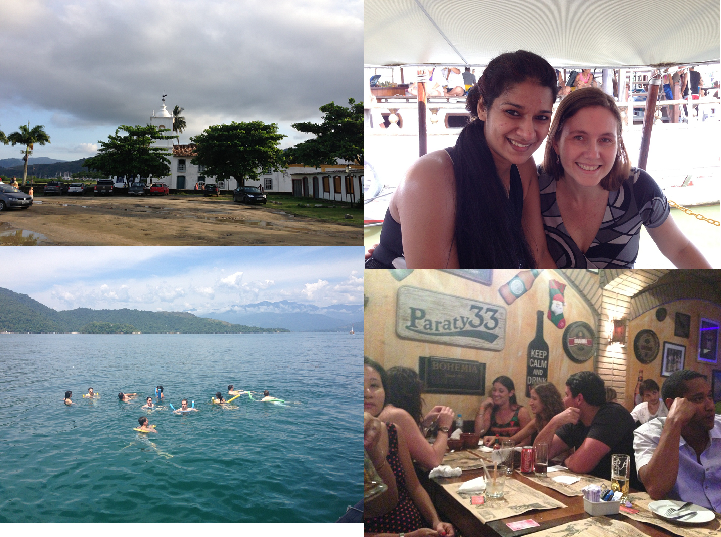
From left clockwise: Paraty like all well preserved colonial towns takes you to a different era complete with beautiful baroque churches like the one here, Prof. Maria and I on the boat – our super nice professor for this trek, the team having a good time in Paraty 33, our group enjoying a beautiful blue spot in the Paraty waters
Day 6
We left for Rio from Paraty visiting the Volkswagen operations in Brazil enroute at Resende. Volkswagen do Brazil manufactures the MAN trucks and buses for Volkaswagen Germany. Brazil’s automobile sector is one of the most interesting. The lack of paved roads in many parts of the country means that the vehicles are constructed to be very robust. But more importantly it is the innovation in fuel usage that impresses you. Many automobile models are built to run on at least 2 fuels (gasoline and ethanol) if not multi fuels (which includes blending ethanol and gasoline and CNG). Brazil is a big producer of sugar cane based ethanol and hence ethanol is a widely used cheaper fuel in Brazil. Almost all gas stations in Brazil sell Ethanol fuel as well.
Volkswagen do Brazil has a very interesting system of production which is called the modular system of production. Here the vendors and suppliers to Volkswagen produce and assemble their parts onsite. Thus, most employees in this plant are not only employees of Volkswagen, but also employees of the vendors and suppliers. This modular system of production also helps Volkswagen change assembly production schedules with the highest flexibility, since the suppliers and vendors are now onsite, in the same assembly line, reacting and responding to the same production requests. We left Resende and reached Rio de Janeiro early evening. Finally a great team dinner at the excellent Gula Gula restaurant summed up the day and night!
Day 6
Our day started with a visit to the famous H Stern headquarters in Ipanema. H Stern educated me about consumerism and marketing in a whole new way. H Stern was started in Rio De Janeiro by Mr. Hans Stern who was a Jewish German immigrant and who came to Brazil from Germany during World War II. He is credited with changing the face of the Brazilian gem industry. He is also famous for challenging the word ‘semi-precious’ for gems, which as per him made as much sense as a ‘semi-pregnant woman’ or a ‘semi-honest man’. H Stern asks people to buy gems not as a status symbol or for showing off to others, but rather as a commodity that helps make one’s inner self happy about owning a beautiful piece of luxury.
Very inspired I decided to buy gems for my mother. One caution – keep a good budget as H Stern does not sell gems at low cost. Of course their gems are certified for authenticity world-wide and their prices are very carefully set as per the gem quality. Also, you can exchange the H Stern gems in any H Stern store world-wide. Hence, I was confident that if my mother did not like the gems I selected, she could exchange them in the H Stern store in New York! Also, you get a factory tour when you visit the H Stern headquarters, so do not miss that. We then went visiting the famous landmark in Rio – Christ the Redeemer. This statue has become an icon for Rio and Brazil and should not be missed if visiting Rio.
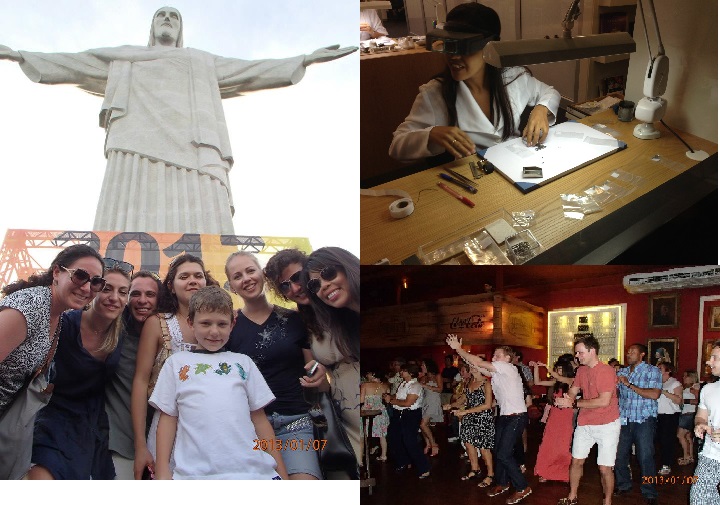
From left clockwise: our group members near Christ the Redeemer, H Stern employee working with precision on their gems, our group members practicing their Samba skills at Rio Scenarium
After finishing Christ the Redeemer we had a great night of Samba dancing at Rio Scenarium. Rio Scenarium is in the historic Lapa district of Rio, a neighborhood very famous among tourists especially for its bars and night clubs. Rio Scenarium has been named one of the top ten bars of the world by the British newspaper ‘The Guardian’. While I was not a particular fan of the food, which was quiet passable honestly, the live music was a whole different matter. Live Samba music started playing and a woman with some of the strongest vocals I have heard started belting out Samba numbers which the Brazilians in our group seemed to identify very well. We danced the night away doing some Samba!
Day 7
We went to visit Petrobras, the state owned Oil Company that has lately been a lot in the news due to the pre-salt discoveries near the states of Sao Paulo and Rio. Pre-salt discoveries have excited the Brazilian and world oil industry, since if the prospects of oil are as predicted /assessed, then Brazil would become the 6th largest producer of oil. Currently it is the 9th largest producer of oil. Given that Brazilians also use ethanol for their fuel, the export possibilities for gasoline are really high. Petrobras is the largest company in the southern hemisphere as per market cap. We heard from their investor relations person..
We then went on one great journey of discovery at least for me. We visited Cantagalo, one of Rio’s most famous Favelas located between Copacabana and Ipanema. We were guided by the locals there and understood more about the life and culture in the favela. A local FGV professor has started many programs for improving the lives of the favela people post-pacification. More about pacification is described later. One of the programs the professor has started involves teaching young kids English so they can teach tourists how to fly kites. Before the pacification, the kids were taught to use kites by the drug dealers to alert the dealers that danger in the form of police or other law enforcement was near the favela. After pacification, the FGV professor decided to give a positive spin on the kite flying skills of these children and hence started this program. I knew how to fly a kite, but had not done it in years. It was so much fun doing it again!
This favela has also been ‘pacified’ and hence is safe for people outside the favela to visit. Pacification is the process by which the police and army enter the favelas, capture or kill the people who are causing violence in the favelas, especially the people dealing with drugs. Pacification finally involves the special pacification force, the UPP, monitoring the favelas and reassuring the favelas. Most of the pacification work in Rio started as a consequence of Rio’s bid for the Olympics. Hence there is skepticism among some Brazilians if the pacification is indeed deep and permanent. Only time will tell if it persists beyond the Olympics. Till then I only pray that it is indeed permanent and that the favela folks can enjoy the peace and opportunities that come with peace since they truly deserve it. We also got spot Samba lessons and were filmed by the local television. Few links to our TV coverage in Portuguese are here
http://www.rj.gov.br/web/guest/exibeconteudo?article-id=1404417
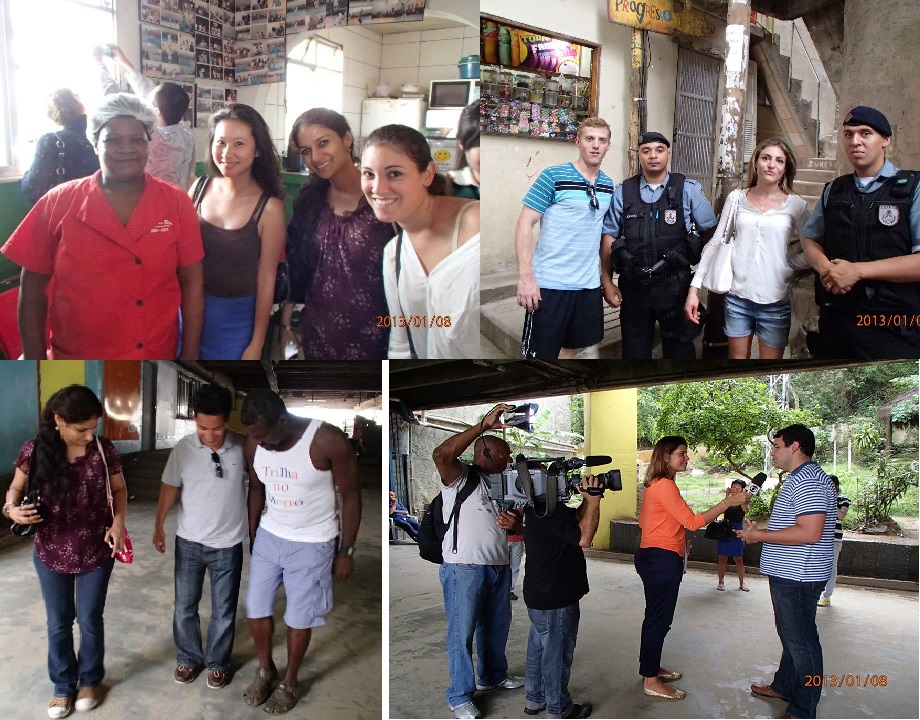
From left clockwise: Some of us with a lady in the Favela who runs her own ‘diner’ outlet, Johnson students with the pacification police (UPP) at the favela, Gustavo our classmate being interviewed by the TV crew, Haider and I getting Samba lessons from the Samba master himself
Day 8
The day started with a visit to the American chamber of commerce where a US Consul met us as well. Brazil has many exciting things going on right now that will be attractive to American businesses. For one, American culture has a huge impact on Brazil as far as I can see. Hence, American products will always have a strong market here. Brazil has also been a fast growing emerging market for many years becoming the 6th largest economy in the world in 2012. With the World Cup and the Olympics happening in Rio in 2014 and 2016 respectively, it is a great time for American businesses to explore Brazil and Rio for market opportunities for infrastructure and other commodities. We spoke to the panel about these different opportunities and also spoke about possibilities of a free trade agreement with Brazil.
This was followed by a visit to the PWC office in Barra da Tijuca. The PWC presentation was about Brazil and its work culture. I was very pleasantly surprised that Brazilians start working while they are finishing their undergraduate degree (exceptions being doctors and some engineers). They attend evening classes to complete their undergraduate degree. As the PWC presenter rightly said, while people think that Brazilians are all about carnivals, football and parties, Brazilian life is actually very difficult, especially if one wants to rise in life using college degrees. I had a new found respect for Brazilian college majors after this talk.
Finally we went to Sugar Loaf Mountain, through a cloud burst, an experience few of us will forget. I was told that on any other clearer day, the sugar loaf mountain would be filled with tourists. We had an almost private cable car experience to the mountain, which was no surprise considering the view from the cable car looked like this!

Figure 26 – View from the cable car taking us to the sugar loaf mountain
After finishing Sugar Loaf mountain and becoming dry again, we all had a great farewell dinner as we bid adieu to a great trip!
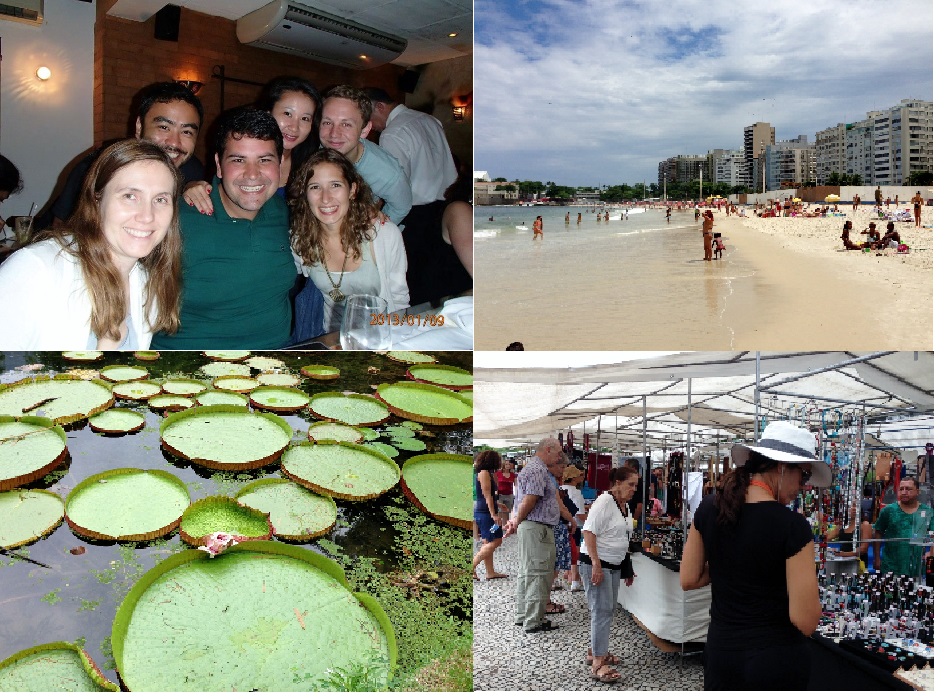
From Left Clockwise: Some members of the team with our tour guide Marianna and Filipe during the farewell dinner, a view of the beautiful Copacabana beach, the hippie fair in Ipanema on Sundays, giant lilies from the Amazon in the Rio botanical garden
I stayed back for 3 more days in Rio after the official end of trip to explore Rio, which was a great decision. This is because all throughout the course of the school trip to Rio, Rio had been pouring, making it almost impossible to go and enjoy the beach or the city. Do buy ‘Copenhagen’ chocolates, a famous brand of chocolate in Brazil or buy from their lower cost but still high quality alternative product line called ‘Brazil Cocoa’. You can find their retail outlets in Ipanema easily. Do ask locals and buy some great Brazilian coffee from the store. If you are a coffee drinker or have friends who love coffee, you will not regret it.
I also went on a visit to the Botanical Gardens in Rio. While this may sound boring at first, think about the fact that they have an entire section devoted to the Amazon! If you have not seen the Amazon, you have missed something and the botanical garden experience can only in part fulfill this void. The trees in the Amazon section look right out of a Lord of the Rings type Hollywood movie, only in this case they are neither studio made plastic trees nor computer generated images, but real living and breathing species! I also took a tour of the lake in Rio where I could even see the big Synthetic Christmas tree that I was told is fully lit up during the holiday season. I also visited the Ipanema hippie fair. If you are in Rio on a Sunday, do not miss the fair that is set up between the Copacabana and Ipanema beaches. You can buy all kinds of souvenirs here. Of course, all items in this fair are over-priced since they cater to tourists. But if you are a good bargainer like me, you will do fine. Finally I spent hours and hours on the beautiful beaches of Rio, which is the most relaxing thing I have ever done in my life. A couple of things to definitely do, based on my limited two week knowledge of Brazil – do try all the bakery and bread items in Sao Paulo. Do try acai, even though I am told it is high in calories, because it’s tasty and good for your health, do drink all the fresh juices that are served in all Brazilian restaurants, do drink the tender coconut at the beaches, do try learning Brazilian Portuguese because it’s one of the sweetest sounding languages.
After my trip I have a new found appreciation for Brazil. Its citizens are very hardworking, very self-respecting and are slowly developing a very positive Brazilian identity thanks to all the progress their country is making. They are extremely kind, inviting, friendly, inclusive and helpful, a trait that will help any tourist not well versed with Portuguese or the country! Also, they have their own unique ways of enjoying life including their famous soap operas, their samba, their carnivals, their football, their cachaca and last but not the least – their beautiful beaches. It is a country anyone can easily fall in love with.
Oi Brazil! eu te amo! Hey Brazil! I love you!
